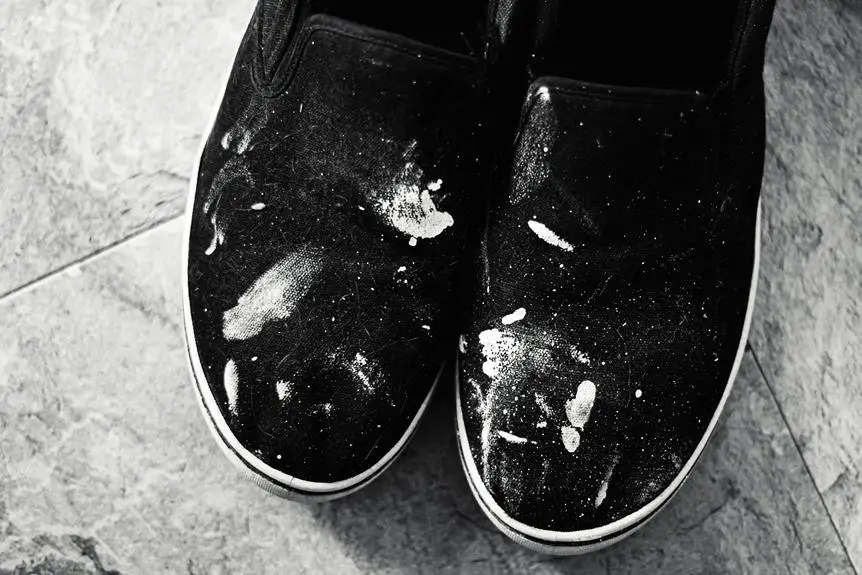We all encounter those frustrating moments when a beloved fabric gets stained, whether it's red wine at dinner or a coffee spill during your morning rush. You might think that certain stains are permanent, but with the right techniques, you can often restore your items to their former glory. From tackling grease marks to dealing with ink and chocolate smudges, knowing how to address these common issues can save you time and money. So, which stains are most challenging, and what methods can give you the best results? Let's explore some effective solutions.
Table of Contents
Key Takeaways
- For red wine stains, blot gently, sprinkle salt, and use club soda to lift the stain before rinsing with cold water.
- Treat grease and oil marks by blotting, applying baking soda, then using dish soap before rinsing with warm water.
- Remove ink stains by blotting, using rubbing alcohol, and rinsing with cold water; repeat as necessary for stubborn stains.
- Coffee and tea spills should be blotted, rinsed immediately, and treated with soap before laundering according to care instructions.
Red Wine Stains
Dealing with red wine stains can be frustrating, but quick action can save your fabric from permanent damage. As soon as you notice a spill, grab a clean cloth and blot the area gently. Don't rub, as this can push the stain deeper into the fibers.
Next, sprinkle some salt onto the stain. Salt acts as an absorbent, drawing out the wine. Let it sit for a few minutes before brushing it off. If you have club soda handy, pour a small amount over the stain and blot again. The carbonation can help lift the stain from the fabric.
Once you've done that, rinse the area with cold water. If the stain persists, mix a solution of equal parts white vinegar and dish soap. Apply this mixture to the stained area and let it sit for about 30 minutes. Afterward, rinse again with cold water.
Grease and Oil Marks
Grease and oil marks can be tricky to tackle, but acting quickly can make all the difference in restoring your fabric. Here's a step-by-step guide to help you eliminate those stubborn stains:
- Blot the Stain: Use a clean cloth or paper towel to gently blot the stain. Don't rub, as this can spread the grease further.
- Sprinkle Powder: Apply a generous amount of baking soda or cornstarch over the stain. Allow it to sit for about 15 minutes to absorb the grease.
- Brush It Off: After letting it sit, gently brush away the powder with a soft-bristled brush or cloth. This should lift some of the grease with it.
- Apply Dish Soap: Treat the stain with a few drops of liquid dish soap. Use your fingers to work it into the fabric, then rinse with warm water.
If the stain persists, repeat the process or consider using a stain remover specifically designed for oil and grease.
Remember to always check the fabric care label before applying any cleaning solution.
With these steps, you can restore your fabric to its former glory!
Ink and Pen Stains
Ink and pen stains can be particularly frustrating, but with the right approach, you can effectively remove them from your fabric.
First, act quickly—blot the stain gently with a clean, dry cloth to absorb as much ink as possible. Avoid rubbing, as this can spread the stain.
Next, choose a suitable stain remover. Rubbing alcohol or hand sanitizer works well for most ink stains. Apply a small amount directly to the stain, using a cotton ball or cloth. Let it sit for about five minutes, allowing the alcohol to break down the ink.
Afterward, rinse the area with cold water to remove the alcohol and loosened ink. If the stain persists, repeat the process.
For stubborn stains, consider using a commercial stain remover designed for ink. Follow the instructions carefully.
Coffee and Tea Spills
Coffee and tea spills can leave unsightly stains on fabric, but quick action can help you tackle them effectively. Here's a step-by-step guide to get your fabric looking clean again:
- Blot the Stain: Use a clean cloth or paper towel to blot the spill immediately. Don't rub it, as that can spread the stain further.
- Rinse with Cold Water: Hold the stained area under cold running water for a few minutes. This helps dilute the coffee or tea and minimizes the stain's impact.
- Apply a Stain Remover: Use a stain remover or a solution of dish soap and water. Gently work it into the fabric with your fingers or a soft brush.
- Launder as Usual: Wash the fabric according to the care label instructions. Check the stain before drying; if it's still visible, repeat the previous steps before drying.
Chocolate Smudges
Chocolate smudges can be tricky to remove, but acting quickly can make a big difference in restoring your fabric.
First, scrape off any excess chocolate using a dull knife or a spoon. Be careful not to rub it further into the fabric.
Next, turn the fabric inside out and run cold water through the back of the stain. This helps push the chocolate out rather than spreading it.
Once you've rinsed it, apply a stain remover or a mix of liquid laundry detergent and cold water directly to the affected area. Gently work it into the fabric with your fingers or a soft-bristled brush.
Let it sit for about 5 to 10 minutes. Afterward, rinse it thoroughly under cold water to remove the detergent.
If the stain persists, repeat the process or consider soaking the fabric in cold water with a bit of detergent for 30 minutes.
Finally, launder as usual, but avoid using hot water or drying until you're sure the stain is gone. Heat can set the stain, making it harder to remove.
With these steps, your fabric can be chocolate-smudge-free in no time!
Grass and Dirt Marks
After tackling chocolate smudges, you might find yourself facing the challenge of removing grass and dirt marks from your fabric. These pesky stains can be stubborn, but with the right approach, you can restore your clothes to their former glory. Here's a quick guide to help you out:
- Act Fast: The sooner you treat the stain, the better your chances of removal. Blot the area gently with a clean cloth to absorb any excess dirt.
- Use Cold Water: Rinse the fabric under cold water to loosen the stain. Avoid hot water, as it can set the stain.
- Apply Stain Remover: Choose a suitable stain remover or make a paste of baking soda and water. Apply it directly to the stain and let it sit for about 15 minutes.
- Wash Normally: Launder the garment as per the care label instructions. Check the stain before drying; if it persists, repeat the process.
Blood Stains
When you spot a blood stain, acting quickly is key to preventing permanent damage.
You'll want to start with immediate treatment steps to lift the stain before it sets in.
Once you've tackled that, effective cleaning solutions can help you get your fabric back to its original state.
Immediate Treatment Steps
To tackle blood stains effectively, act quickly to prevent the stain from setting into the fabric. Here's what you should do immediately:
- Blot the stain: Use a clean cloth or paper towel to gently blot the blood stain. Avoid rubbing, as this can spread the stain further.
- Rinse with cold water: Hold the stained area under cold running water for several minutes. This helps to flush out as much blood as possible from the fabric.
- Soak in cold water: If the stain persists, soak the fabric in a bowl of cold water for about 30 minutes. Ensure the stained area is fully submerged.
- Check the stain: After soaking, examine the stain. If it's still visible, you may need to repeat the blotting and rinsing steps before moving on to more effective cleaning solutions.
Effective Cleaning Solutions
What cleaning solutions can you use to effectively remove blood stains once you've treated them immediately? You have several options at your disposal that can help lift those unsightly marks from your fabric. Here are some effective methods you can try:
| Solution | Instructions |
|---|---|
| Cold Water | Rinse the fabric under cold water for 10-15 mins. This helps to loosen the blood. |
| Hydrogen Peroxide | Apply directly to the stain, let it bubble for a few minutes, then blot with a clean cloth. |
| Salt Paste | Mix salt with cold water to form a paste. Apply it to the stain and let it sit for 30 mins before rinsing. |
| Dish Soap and Water | Mix dish soap with cold water, soak the stained area, and gently scrub with a cloth. |
Always test each solution on a hidden part of the fabric first to ensure it won't cause damage. After treating, wash the fabric as usual, but avoid heat until you're sure the stain is completely gone. Heat can set the stain, making it more difficult to remove.
Frequently Asked Questions
Can I Use Bleach on All Fabric Types to Remove Stains?
You can't use bleach on all fabric types. It can damage delicate materials like silk or wool. Always check care labels and test a small area first to avoid ruining your clothes.
How Do I Prevent Stains on My Clothing Before They Occur?
To prevent stains on your clothing, you can wear protective gear, choose darker colors, and avoid eating near your garments. Regularly treat and wash your clothes to keep them looking fresh and stain-free.
Is It Safe to Use Hot Water on All Stains?
It isn't always safe to use hot water on all stains. For some, like protein-based stains, hot water can set the stain. Always check the fabric care label and stain type before washing.
What Are the Best Products for Stain Removal at Home?
To tackle tough stains at home, you'll want to grab products like baking soda, white vinegar, and dish soap. They're effective and safe for most fabrics, helping you achieve a clean, stain-free result effortlessly.
How Can I Treat Old or Set-In Stains Effectively?
To treat old or set-in stains effectively, you can pre-soak the fabric in a mixture of warm water and detergent. After soaking, scrub gently and rinse thoroughly to lift the stain away.
- The Use of Nonwovens in Construction and Civil Engineering - July 11, 2025
- The Use of Nonwovens in Construction and Civil Engineering - July 11, 2025
- The Use of Nonwovens in Construction and Civil Engineering - July 11, 2025







